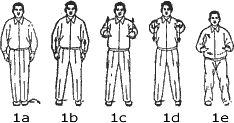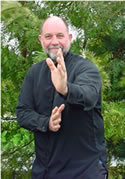Variations of names for this movement
include: WuJi, Standing Quietly,
Reconnecting with Oneness and Emptiness, Quiet Standing
Mediation
Beginning, Commencement, Starting Posture, Commencing (Qishi), Taijiquan Opening Movement, and 预 备 : Yu Bei : Preparation Form.
Beginning, Commencement, Starting Posture, Commencing (Qishi), Taijiquan Opening Movement, and 预 备 : Yu Bei : Preparation Form.
Face N 12 (1a) . For an explanation of the directional scheme used in Cloud Hands webpages, please see below.
Stand at attention for awhile. In Taiji and Qigong, standing quietly in a meditative posture for awhile is the first phase. Relax (Sung). Shoulders are down, hands relaxed and gently touching the side of leg, and head is erect. This is the phase of WuJi (empty state), or standing like a tree (Zhan Zhuang), and Reconnecting with Oneness and Emptiness. Breathe easily and comfortably.
Sink weight into right leg, and then step out to the left to shoulder width (1b).
Gently raise both arms up (1c), palms facing down, to about shoulder height (1d).
Lower both arms, palms down, to Dan Tien height, and lower knees (1e). The lower Dan Tien is a sphere of energy located a few inches behind and below the level of the navel or belly button; the middle Dan Tien is located in the heart area, and the upper Dan Tien is located behind the eyes in the brain. The most important for Taijiquan is the lower Dan Tien. Practitioners of Kundalini Yoga might consider correspondences of the 3rd Chakra (Manipurna) [Power, Will] with the Lower Dan Tien, the 4th Chakra (Anahata) [Compassion, Love] with the Middle Dan Tien, and the 6th Chakra (Aina) [Intuition, Vision, 6th Sense] with the Upper Dan Tien. The Chinese energetic system is quite different from the Indian energetic system, so correspondences are weak in this case. [Chris Akley wrote on 4/3/2012 that "Though I wouldn't say that this is wrong, I think there is a more accurate way to describe it. You could also say that the Dan Tien is in the second charka Swadhisthana which is where kundalini resides once it is awakened. But more accurately, I would say it is between the second and third chakra as this Qigong healer says, in between the energies of fire and water.]
This is movement often called "Raising Hands and Lowering Hands."
Breathe normally as you stand, relax, and center in position 1a. Breathe in through nose, and out through the nose. Slow the respiration rate to inhaling for 4-5 seconds, holding the full in-breath for 1-2 seconds, exhaling slowly for 4 to 5 seconds, pausing 1-2 seconds before beginning the yin/yang cycle of breathing again. Breathe in at 1a, breathe out as you step to 1b.
Breathe in as arms float up 1b-1c, and breathe out as arms float down (1d-1e).
Here is a description of the beginning of the Opening
Posture of Taijiquan (#1, 1b)
from the book
Traditional Chen Style Taijiquan
by Fan Chun-Lei and A. Frank Shiery, p.37:
"1. Preliminary Stance:
Stand naturally upright with the feet placed shoulder-width apart, toes pointed
slightly inward, and arms hanging naturally at the side. The body should
be kept upright with the shoulders relaxed, eyes slightly closed and breathing
naturally. The body should face north. The mind should remain empty,
calm and clear. This is the state of WuJi, (Negative Terminus in
Taoist Teaching).
2. Commencing Form: The body should exhibit being relaxed externally while solid within. The head is held naturally erect as if pulled upward by an invisible string. Close the lips slightly with the tongue touching the upper palate. The toes firmly grasp the ground with Yongquan point pulled upward. The eyes are looking straight ahead with the chin drawn slightly inward. The hip is turned up and the coccyx turned back and upward with the waist directed downwards. The whole body should remain relaxed. A mind state of intent is maintained while the vital energy flows upward from the Dantian to the Baihui point, while the turbid energy flows downward from the Dantian to the Yongquan point. During this time, the body exhibits no external movement. Yin/Yang, for example, closing/opening, supple-firm and fast-slow are manifested internally, portraying the image of the Taiji, (Grand Terminus) (1b).
Key Points to Remember: For the beginner, the primary concern should be to cleanse the mind and spirit of tension and anxiety, removing all negative thoughts. This develops even-temperedness and an alert mind for quick movement and response. Once this technique has been mastered, the practitioner can begin to understand and practice Taijiquan more effectively."
- Fan Chun-Lei and A. Frank Shiery, Traditional Chen Style Taijiquan
2. Commencing Form: The body should exhibit being relaxed externally while solid within. The head is held naturally erect as if pulled upward by an invisible string. Close the lips slightly with the tongue touching the upper palate. The toes firmly grasp the ground with Yongquan point pulled upward. The eyes are looking straight ahead with the chin drawn slightly inward. The hip is turned up and the coccyx turned back and upward with the waist directed downwards. The whole body should remain relaxed. A mind state of intent is maintained while the vital energy flows upward from the Dantian to the Baihui point, while the turbid energy flows downward from the Dantian to the Yongquan point. During this time, the body exhibits no external movement. Yin/Yang, for example, closing/opening, supple-firm and fast-slow are manifested internally, portraying the image of the Taiji, (Grand Terminus) (1b).
Key Points to Remember: For the beginner, the primary concern should be to cleanse the mind and spirit of tension and anxiety, removing all negative thoughts. This develops even-temperedness and an alert mind for quick movement and response. Once this technique has been mastered, the practitioner can begin to understand and practice Taijiquan more effectively."
- Fan Chun-Lei and A. Frank Shiery, Traditional Chen Style Taijiquan
"Try this simple experiment now.
Raise your right hand toward the ceiling. Just do it. Then take it
back down/ What did you see? What did you experience? Now,
raise your right hand to the ceiling very slowly. Take at least thirty
seconds to do it. Then take it back down again, just as slowly.
Don't think abou it, or try to analyze it. "Just do it"─ but very slowly.
Now, what did you notice; what did you see this time? Were you able to notice the impulse that precedes the movement? The complex mental/physical twinge that sets the arm in motion? Did you see and feel the weight and volume of the arm? Were there any changes in the quality of your mind or breath as the arm slowly rose or descended? Were there mental formations, perhaps of boredom, irritation, curiosity, pleasure? A whole cosmos arises, changes, and passes away in one simple movement, and generally we are completely blind to all of it. Generally, until there has been a deep and real transformation at the base, when we simply "do what we are doing," we are merely dong conditioned, habitual actions. Moving slowly allows us to see this more clearly and leads to ceto-vimutti, liberation of the mind. It does this by giving us the time and space to see the constant process of conditioning arising here in this body-mind. And in seeing the conditioning, we can begin the process of freely choosing how to respond, rather than blindly react."
- Frank Jude Boccio, Mindfulness Yoga: The Awakened Union of Breath, Body, and Mind, 2004, p.89
Standard Bejing 24 Movement T'ai Chi Ch'uan Form in the Yang Style
Taijiquan: Lessons, Styles, Forms, Practices
Now, what did you notice; what did you see this time? Were you able to notice the impulse that precedes the movement? The complex mental/physical twinge that sets the arm in motion? Did you see and feel the weight and volume of the arm? Were there any changes in the quality of your mind or breath as the arm slowly rose or descended? Were there mental formations, perhaps of boredom, irritation, curiosity, pleasure? A whole cosmos arises, changes, and passes away in one simple movement, and generally we are completely blind to all of it. Generally, until there has been a deep and real transformation at the base, when we simply "do what we are doing," we are merely dong conditioned, habitual actions. Moving slowly allows us to see this more clearly and leads to ceto-vimutti, liberation of the mind. It does this by giving us the time and space to see the constant process of conditioning arising here in this body-mind. And in seeing the conditioning, we can begin the process of freely choosing how to respond, rather than blindly react."
- Frank Jude Boccio, Mindfulness Yoga: The Awakened Union of Breath, Body, and Mind, 2004, p.89
Standard Bejing 24 Movement T'ai Chi Ch'uan Form in the Yang Style
Taijiquan: Lessons, Styles, Forms, Practices


No comments:
Post a Comment